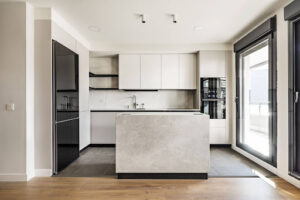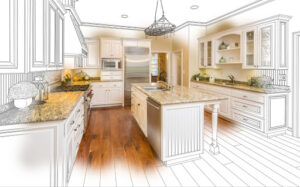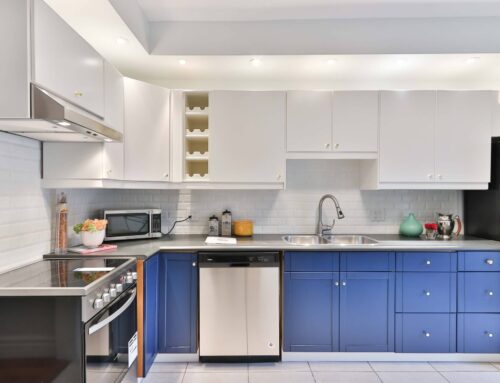When we think about the heart of our homes, the kitchen stands out as a central hub of activity, from preparing daily meals to hosting memorable gatherings.
This is why designing the perfect kitchen layout is crucial for any home remodeling project. In this article, we’re diving into essential kitchen design layout tips to ensure your space is not only beautiful but highly functional.
We’ll share insights on making the most of your kitchen, whether you’re embarking on a minor update or a major renovation.
Keep these tips for kitchen design layout in mind as you plan your project for a space that’s truly the heart of your home.
Understand Your Space
First and foremost, understanding your kitchen’s dimensions is key. Before we dive into the aesthetics, let’s talk about the skeleton of your kitchen layout.
Measuring your kitchen’s dimensions gives you a clear picture of the space you have to work with. This is where our journey to a perfect kitchen begins.
Next, we can’t overlook the importance of the work triangle. This concept, which arranges the sink, stove, and refrigerator in a triangular layout, is fundamental for achieving an efficient kitchen design.
It’s about making your kitchen work for you, minimizing unnecessary movement, and making cooking and cleaning as seamless as possible.
For those of us dealing with smaller kitchens, this phase is about getting creative with the space available. It’s about embracing minimalism not just as a design aesthetic but as a functional approach to living.
This doesn’t mean you have to compromise on style or functionality; rather, it’s about making every inch count. And for those with larger kitchens, the challenge is to keep the space from feeling too vast or impersonal.
Here, zones can be incredibly useful, designating specific areas for cooking, dining, and socializing.
Choose Your Layout Wisely
Moving on to selecting your kitchen layout, this is where your personal style starts to shine through. Whether it’s the classic L-shaped kitchen, a spacious U-shaped layout, a compact galley, or incorporating an island or peninsula, each has its unique advantages. Our kitchen remodeling advice? Choose a layout that mirrors your lifestyle and cooking habits.
An L-shaped kitchen works wonders in open-concept homes, promoting a seamless flow between the kitchen and living areas. U-shaped kitchens are great for those who crave ample countertop space, offering plenty of room for meal prep and storage.
The galley kitchen, efficient and streamlined, is perfect for narrow spaces, ensuring everything you need is within reach. And let’s not forget the island and peninsula layouts, which offer additional workspace and can become a focal point for socializing.

But beyond the immediate appeal of these layouts, think about your future needs. Our homes evolve just as we do, so incorporating flexibility into your kitchen design is a smart move. This foresight is part of what we consider the best renovation practices, ensuring your kitchen remains functional and stylish for years to come.
Maximize Storage Solutions
An often underappreciated aspect of kitchen design is storage. The right storage solutions can make your kitchen appear cleaner, larger, and more organized. Innovations like pull-out cabinets, corner drawers, and overhead pot racks not only save space but also make accessing your utensils, cookware, and ingredients a breeze.
When planning your kitchen remodeling, consider how to balance aesthetics with functionality. Opt for storage options that complement your kitchen’s design while keeping everything you need within easy reach.
One of our favorite kitchen design layout tips is to declutter your counters and organize your storage areas by frequency of use to significantly enhance your kitchen’s functionality and appearance.
Lighting and Ventilation
Lighting plays a pivotal role in setting the tone and functionality of your kitchen. A well-lit kitchen uses a mix of ambient, task, and accent lighting to create a warm and inviting atmosphere while ensuring safety and efficiency during food preparation.
Consider installing under-cabinet lights to illuminate your countertops and pendant lights to add style and focus to your kitchen island.
Proper ventilation is equally important, especially in open-concept layouts where kitchen smells can easily spread to other living areas. A quality range hood can remove smoke, grease, and odors, keeping your home fresh and clean.
Integrating your ventilation system into your kitchen’s design can be a challenge, but it’s crucial for maintaining a comfortable environment. This is a critical aspect of home remodeling that often goes overlooked but is essential for both comfort and health.
Personalize Your Space
Finally, the most enjoyable part of kitchen design is personalizing your space. This is your opportunity to infuse your kitchen with your personality and style. Choose a color scheme that reflects your taste, whether it’s calming neutrals or vibrant hues.

Select materials and finishes that resonate with you, from classic wood to modern metals and glass. Decorative elements like backsplashes, cabinet hardware, and light fixtures can add character and charm to your kitchen.
Remember, the goal is to create a space that feels like home, where functionality meets style in perfect harmony.
Consulting with a professional kitchen designer can provide valuable insights and help you avoid common pitfalls. They can assist in fine-tuning your ideas to ensure your kitchen is not only beautiful but tailored to your lifestyle and needs.
Conclusion
Designing the perfect kitchen layout requires a balance between aesthetic appeal and practical functionality. By following our kitchen design layout tips, including tips for kitchen design layout, kitchen remodeling tips, and best renovation practices, you can create a space that enhances your home and your life.
Remember, the key to a successful kitchen design is understanding your space, choosing the right layout, maximizing storage, ensuring proper lighting and ventilation, and personalizing your space. As we conclude, let these kitchen design layout tips inspire you to create a kitchen that’s not just a place for cooking but a central hub for your home and family.
Embrace the journey of transforming your kitchen with these tips in mind, and watch as your dream kitchen becomes a reality, perfectly blending form and functionality for years to come.
For those who are in need of a helping hand, Point Vertex has you covered. Contact us for all kitchen projects, and our professionals will bring your ideas to life!




